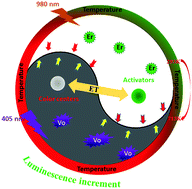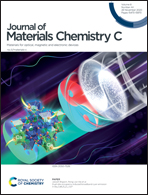Optical control of Er3+-doped M0.5Bi2.5Nb2O9 (M = Li, Na, K) materials for thermal stability and temperature sensing using photochromic reactions†
Abstract
Currently, the conventional ways to enhance thermal stability or temperature-sensing properties are mainly by modulating host lattices and dopant composition. Here, we found that the photochromic reaction based on defect-capture engineering plays an important role in improving thermal stability and temperature-sensing properties. In this work, the photochromic behavior induced by oxygen vacancy-related defects were successfully achieved in a series of Er3+-doped M0.5Bi2.5Nb2O9 (M = Li, Na, K) materials. After 405 nm irradiation, the intensity of the upconversion emission was significantly decreased, and the quenching degree reached up to ΔRt = 80.46%, 91.41%, and 55.29%, respectively. Meanwhile, the thermal stability of luminescent emission improved remarkably in a temperature range from 273 to 753 K, and up to 59.29% (KBN), 72.55% (NBN), and 44.60% (LBN) after the 405 nm light irradiation. Importantly, the optical temperature-sensing exhibited an obvious modification using different temperature response of upconversion emission before and after light irradiation, strongly relying on the photochromic reaction. These results might provide a good strategy for achieving high thermal stability and temperature-sensing performance by controlling the photochromic reactions.



 Please wait while we load your content...
Please wait while we load your content...